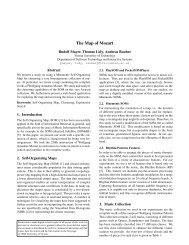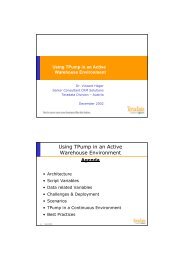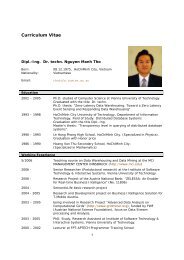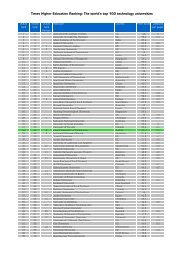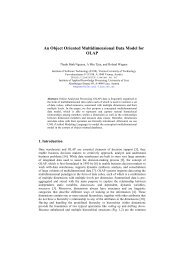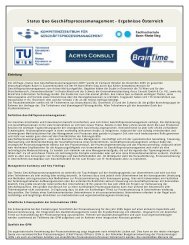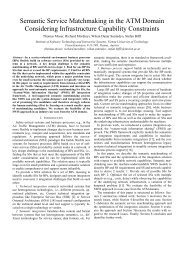Using Ontologies for Enterprise Architecture Model Alignment
Using Ontologies for Enterprise Architecture Model Alignment
Using Ontologies for Enterprise Architecture Model Alignment
Create successful ePaper yourself
Turn your PDF publications into a flip-book with our unique Google optimized e-Paper software.
2 G. Antunes, A. Caetano et al.<br />
tems, and infrastructure” whose models “focus on alleviating the infamous business–in<strong>for</strong>mation<br />
technology alignment problem” [1]. <strong>Alignment</strong> results from applying<br />
models, methods, patterns and best practices to the specification and<br />
governance of the different domains of an organisation[2, 3, 4, 5]. Managing<br />
dependencies is fundamental <strong>for</strong> supporting the communication between the different<br />
stakeholders and to maintain the consistency at model and meta-model<br />
level [6, 7]. Moreover, EA governance requires the ability to analyse artefacts<br />
[1, 8] and it is also required to assist business analytics [9].<br />
Despite the ef<strong>for</strong>ts <strong>for</strong> developing comprehensive approaches to architecture,<br />
such as TOGAF [10], a “one model fits all” is unable to address the specific<br />
domains of an organization [11, 12]. Different organizations have specific needs<br />
and thus place particular demands on the EA models’ artefacts. As such, the<br />
development of an architecture description language entails ensuring the consistency<br />
and traceability between the language concepts [13, 1]. On the other hand,<br />
creating a consistent and comprehensive architecture description language that<br />
deals with specific domains is a challenge despite existing situational method<br />
approaches to enterprise architecture management [14].<br />
According to the ISO 42010 standard, the usage of multiple views is fundamental<br />
to describe a system’s architecture. A system has multiple stakeholders,<br />
each with specific interests on the system. An architecture description should<br />
aggregate multiple views, materialized in a set of models, that are <strong>for</strong>mulated according<br />
to viewpoints expressing the concerns of the stakeholders of the systemof-interest<br />
[15]. In this way, an architecture works as a communication agent<br />
between stakeholders, as each is presented with is own view over the system of<br />
interest. Creating viewpoints may actually require using different meta-models,<br />
tools, and validation mechanisms. This creates hurdles to consistency checking<br />
and traceability. The integration and extension of models and underlying metamodels<br />
is common[16, 17]. But such approaches bring challenges at the level<br />
of traceability and consistency because it is difficult to trace concepts between<br />
different domains, a problem that is aggravated as the models evolve [18]. Moreover,<br />
the integration of different meta-models poses challenges to its validation<br />
[19].<br />
This paper is concerned with the question of how to enhance enterprise architecture<br />
modelling with regards to consistency and traceability. In this context,<br />
consistency means the quality of the artefacts being logically related. The goal is<br />
to integrate multiple enterprise architecture description languages as a means to<br />
assist alignment. Specifically, we investigate whether ontology technologies can<br />
be used to specify, integrate and analyse multiple enterprise architecture models<br />
and the underlying meta-models.<br />
<strong>Ontologies</strong> describe a domain model by associating meaning to its terms and<br />
relations. A more <strong>for</strong>mal and widely used definition is that of Grüber who defines<br />
an ontology as a “<strong>for</strong>mal specification of a conceptualisation” [20]. The<br />
importance of this technology is evidenced by the growing use of ontologies in a<br />
variety of application areas [21, 22] and, especially, by their role on the Semantic<br />
Web initiative [23, 24]. Ontology technologies are also used in the field of enter-



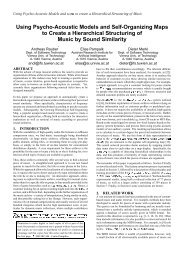


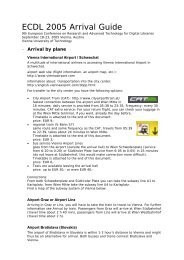
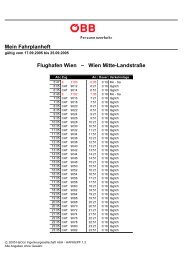
![Informationsvisualisierung [WS0708 | 01 ]](https://img.yumpu.com/22537403/1/190x143/informationsvisualisierung-ws0708-01-.jpg?quality=85)
